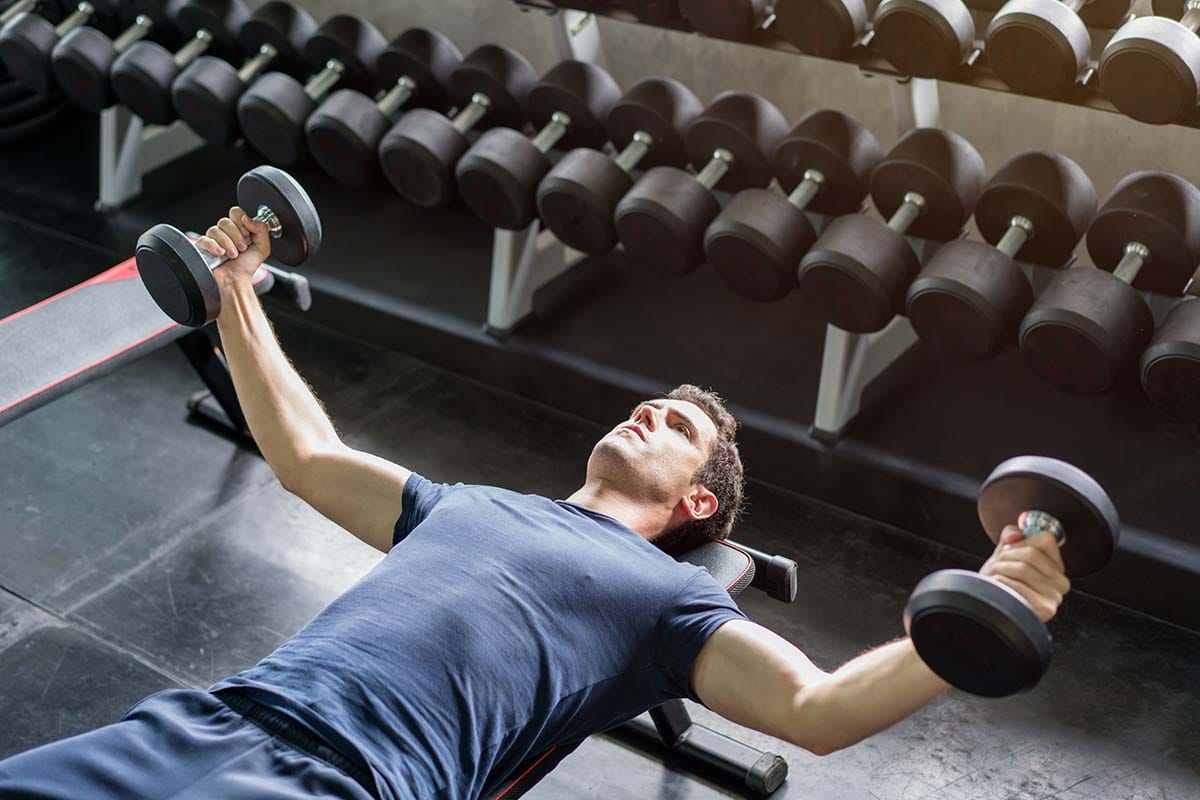Ace the Around the World Exercise: Core Strength and Mobility
We’re going around the world on this one!
When we actually define “around the world exercises” there are likely a few variations you’ve come across floating around online.
Here, we’ll go over a few workouts that people traditionally mean when referring to the “around the world exercise” plus how to perform them. If you’re looking for 3D shoulders and a compact core, look no further than around the worlds.
We’ll also analyze the benefits of around the world exercises, teaching you how you can incorporate them into your weekly workout plan.
Around the World Exercise– Definition

So if you’re doing any research into “around the world” as a workout, you’ve probably heard of two main exercises that are called by this name.
The first is a workout where you swing a kettlebell around the circumference of your body, handing it off from hand to hand as you pick up speed, letting your weight make a wide circle around you in the air.
Another around the world exercise is a simple shoulder exercise where you lift a set of dumbbells up and overhead, following an arcing pattern, like the shape of a snow angel. This description for the exercise is less commonly seen, so we’ll focus primarily on the first category.
For the purpose of this article, the above definitions of the around the world (and related variations) are what we’re going to be covering.
Now that we’ve got that cleared up, let’s see how you can perform around the worlds.
Around the World Exercise Variations

The "Around the World" exercise is a versatile movement you can add to your fitness routine to target various muscle groups. It’s a way to gain coordination and build up your overall strength and flexibility.
Here are a few variations of the "around the world" exercise:
Around the World with a Dumbbell or Kettlebell
Muscles Worked: Shoulders, arms, core.
How-To: Stand with your feet shoulder-width apart, holding a dumbbell or kettlebell in one hand. Swing your weight around your trunk in a circular motion, passing it from one hand to the other at the midpoint when it comes behind your back, and then again once the kettlebell is in front of you. Continue this movement for as long as you’d like.
Stability Ball or Weight Bench Around the World
Muscles Worked: Chest, shoulders, core.
- Set-Up: Lie on a weight bench or a stability ball.
- Position: Keep your upper back and shoulders supported, and your feet flat on the ground. Hold a weight in each hand.
- Action: Lift your arms out to the sides to start. Bring your weights up in an arcing motion to meet over your head.
- Reverse: Sweep your weights back down the way they came so they come to your sides. Continue to move through this pattern.
- Reps: 3-4 sets of 10 reps.
You can modify any variation to suit your fitness levels and goals. The key is staying in control and using good form as you work through these exercises.
That way, you get the most benefits and don’t hurt yourself during your workouts.
Around the World Exercise— Weekly Workout Plan
Here's a full-body weekly workout plan that incorporates around the world exercises. In this plan, you can balance strength training, cardio, and flexibility exercises during your week.
Monday: Upper Body and Core
- Warm-up:
- 5-10 minutes of light cardio (jump rope, jogging, etc.)
- Workout:
- Around the world with dumbbell/kettlebell: 3 sets of 10 reps (each direction)
- Push-ups: 3 sets of 12 reps
- Dumbbell rows: 3 sets of 12 reps (each side)
- Plank with arm reaches: 3 sets of 10 reps (each arm)
- Bicycle crunches: 3 sets of 20 reps (10 on each side)
- Cool-down:
- Stretch your shoulders, chest, and core (5-10 minutes)
Tuesday: Lower Body
- Warm-up:
- 5-10 minutes of light cardio (high knees, butt kicks, etc.)
- Workout:
- Squats: 3 sets of 15 reps
- Front lunges: 3 sets of 12 reps (6 each leg)
- Deadlifts: 3 sets of 12 reps
- Calf raises: 3 sets of 20 reps
- Leg raises: 3 sets of 15 reps
- Cool-down:
- Stretch your legs and lower back (5-10 minutes)
Wednesday: Cardio and Core
- Warm-up:
5-10 minutes of light cardio (jogging, dynamic stretches)
- Workout:
HIIT Circuit: Repeat 3 times
- Jumping jacks: 1 minute
- Mountain climbers: 1 minute
- Burpees: 1 minute
- Plank hold: 1 minute
- Rest: 1 minute
- Cool-down:
- Take a light jog or treadmill walk, followed by core stretches (5-10 minutes)
Thursday: Rest or Active Recovery
- This is a day for a slow-paced walk or stretching
Friday: Upper Body and Core
- Warm-up:
- 5-10 minutes of light cardio (arm circles, shoulder rolls, etc.)
- Workout:
- Around the world exercise with a dumbbell/kettlebell: 3 sets of 10 reps (each direction)
- Shoulder press: 3 sets of 12 reps
- Bent over rows: 3 sets of 12 reps (each side)
- High plank to forearm plank walkdown: 3 sets of 10 reps
- Russian twists: 3 sets of 20 reps (10 per side)
- Cool-down:
- Stretch out your shoulders, arms, and core (5-10 minutes)
Saturday: Lower Body
- Warm-up:
- 5-10 minutes of light cardio (walking lunges, leg swings, etc.)
- Workout:
- Lunges: 3 sets of 15 reps (each leg)
- Goblet squats: 3 sets of 12 reps
- Step-ups: 3 sets of 15 reps (each leg)
- Glute bridges: 3 sets of 20 reps
- Hanging leg raises or windshield wiper workout for abs: 3 sets of 15 reps
- Cool-down:
- Stretch your legs and glutes (runner’s lunge, figure-4 stretch, etc.) (5-10 minutes)
Sunday: Rest or Active Recovery
- Light activities like a long walk
Notes:
- Progressive Overload: Slowly and gradually increase your weights or reps. This helps you keep challenging your muscles as you improve.
- Form: Focus on maintaining proper form. This helps you avoid injuries like impingement syndrome of the shoulder.
- Hydration and Nutrition: Make sure you stay hydrated during your workouts and maintain a balanced diet to support your fitness goals.
Around the World Workout Benefits
Around the world exercises come with a “world” of benefits (pun intended). These exercises can be a great way to improve your fitness level in several ways.
Let’s see what good can come from adding these moves to your workout routine. Here are some of the main advantages:
Shoulder Mobility
These exercises often involve circular motions that help improve the range of motion in the shoulder joints. They also give you more shoulder stability by engaging the rotator cuff and surrounding muscles.
Because around the world require a lot of stability to hold your body up in space, they can also help you counteract sloped shoulders or bad shoulder genetics.
Core Strength & Stability
Many variations of around the world exercises work your core muscles to maintain balance and control. This helps strengthen your abs, obliques, and lower back.
Coordination and Balance
Passing your weight from hand to hand in a circular motion means you need to coordinate between the different muscle groups in your body. This can improve your motor skills and mental coordination. The plank variation on an around the world exercise also lets you challenge this coordination while you work your balance and stability.
This can enhance what’s called “proprioception.” In simpler terms, this is your body’s ability to sense its position in space. Good spatial awareness and a sense of how you’re positioning yourself can be helpful in sports or in alignment for other disciplines like yoga and dance.
Full-Body Engagement
Around the worlds are good examples of compound exercises. That means a move that targets multiple muscle groups or joints at the same time, providing a comprehensive workout. For example, dumbbell around the worlds engage your shoulders, arms, and core at the same time.
Flexibility and Mobility
The range of motion that your arms make and dynamic movement in around the world exercises can help make you more flexible. If you practice these workouts often, you can expect to see more flexibility in your shoulders, hips, and spine.
Better mobility can lower your injury risk and help you get into peak performance shape for other physical activities.
Want more information about maximizing mobility? There are a few simple tests you can do for that! Learn more: Mobility Test.
Functional Fitness
Finally, around the world exercises can simulate movements that you’d do in real life or in sports. The traditional version, where you swing your arms, for instance, would replicate a throwing motion that you’d use in various sports.
Since these exercises mimic everyday movements, they’re practical for improving your functional fitness. They can also help build strength and endurance.
Big Picture
The terminology “around the world exercise” can refer to a few different moves, all of which are solid strategies for building up your shoulders and core muscles.
Typically, people use it to mean the exercise where you’re swinging a kettlebell around the circumference of your body, passing it between hands to create a circle (going around the “world”!).
What this workout does is help you to increase your shoulder strength while you build core stability at the same time.
Open up a “world” of possibilities for your workouts. The Flex App progresses as you do with plate tracking capabilities and auto progression.
Related articles


Get fit with Flex
Build muscle & lose weight fast for free.
Available on iPhone + Apple Watch





